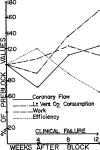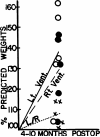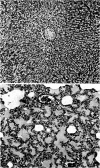Chronic heart block in dogs; a method for producing experimental heart failure
- PMID: 13240809
- PMCID: PMC2950642
- DOI: 10.1161/01.cir.12.2.259
Chronic heart block in dogs; a method for producing experimental heart failure
Abstract
A method is described for the production of chronic atrioventricular block in dogs, by incision of the region of the bundle of His through the open right atrium during temporary caval occlusion. Exercise tolerances, chest x-ray films, electrocardiograms, phonocardiograms, cardiac outputs, intracardiac pressures, femoral pressures, and left ventricular coronary flows were obtained preoperatively and from 1 to 10 months postoperatively. The majority of the animals developed clinical, laboratory, and pathological evidence of congestive heart failure. All animals had generalized myocardial hypertrophy.
Figures













References
-
- Goodale WT, Hackel DB. Measurement of coronary blood flow in dogs and man from rate of myocardial nitrous oxide desaturation. Circulation Research. 1953;1:502. - PubMed
-
- Kety S, Schmidt CF. The determination of cerebral blood flow in man by the use of nitrous oxide in low concentrations. Am. J. Physiol. 1945;143:53.
-
- Erlanger J, Blackman JR. A study of relative rhythmicity and conductivity in various regions of the auricles of the mammalian heart. Am. J. Physiol. 1907;19:125.
-
- Eyster JAE, Swarthout EC. Experimental determination of the influence of abnormal cardiac rhythms on the mechanical efficiency of the heart. Arch. Int. Med. 1920;25:317.
MeSH terms
Grants and funding
LinkOut - more resources
Full Text Sources

